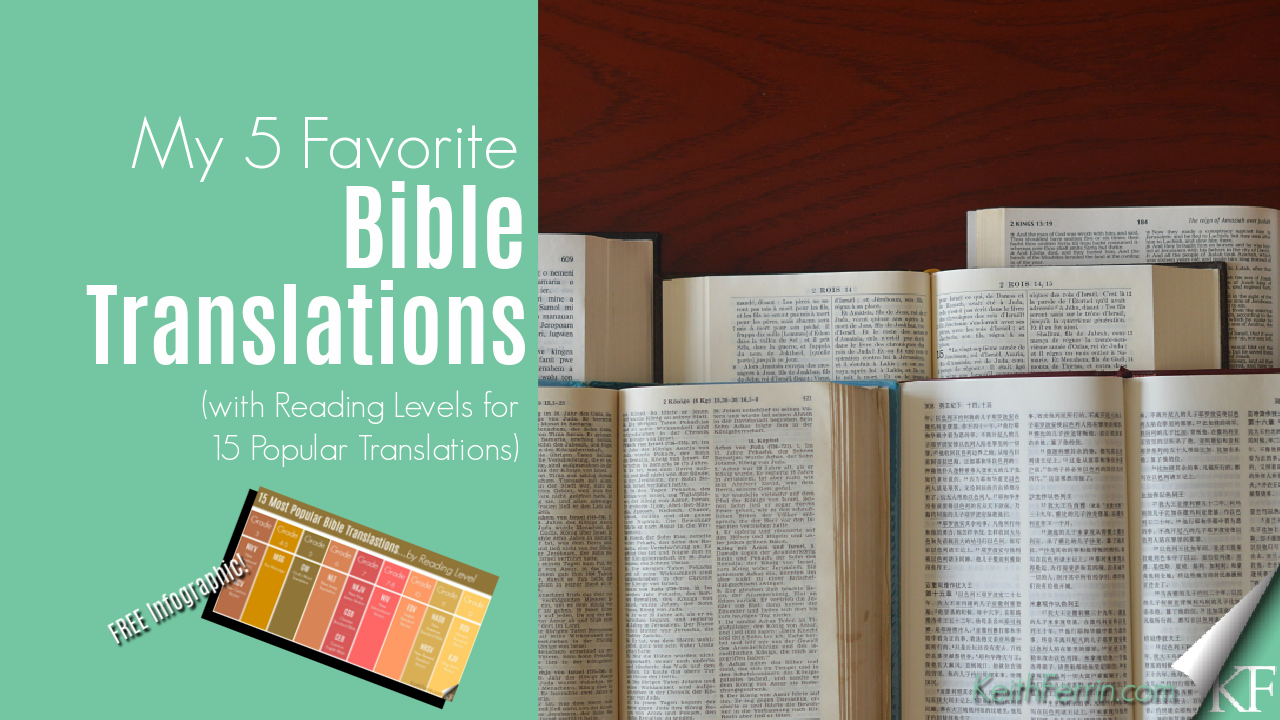
My 5 Favorite Bible Translations (with Reading Levels for 15 Popular Translations)
One of the most common questions I get asked is, What is your favorite Bible translation? Since I’m a bit of a “Bible junkie,” picking one is a bit of a challenge. However, I have narrowed it down to five! (BTW…There’s a really good reason behind each one.)
Here’s where we’re headed in this post…
- First…I’ll share a brief description of my five favorites.
- Second…I’ve posted an infographic with the “reading level” of the 15 most popular Bible translations. (Feel free to download and share.)
My 5 Favorite Bible Translations
Christian Standard Bible (CSB) – This is a new translation as of 2017. It has become my “go to” translation for almost all of my regular reading and study. The translation philosophy is called “Optimal Equivalence,” which is a middle ground between Dynamic Equivalence (thought-for-thought) and Formal Equivalence (word-for-word). When the meaning is clear, they stuck with word-for-word. When the meaning might be obscured, they used thought-for-thought. The result is a fantastic, accurate, readable translation. I also like the fact that their translation team was made up of over 100 scholars from 17 different denominations. (EXCITING NEWS: I have been given permission to record an audio Bible using the CSB! My goal is to have the New Testament completed by the end of 2017.) Here’s the one I have.
New International Version (NIV) – This is the translation I grew up with. It just “sounds right” in my head. The NIV is popular, so it’s easy to find, has lots of resources that go with it, and there is a high percentage that people you discuss the Bible with (which I highly recommend) will be using it too. NOTE: The main change they made in the 2011 update is to take passage that have male pronouns – but aren’t truly gender specific – and translated them with either gender-neutral pronouns or “brothers and sisters” instead of “brothers.” Here’s the one I have.
English Standard Version (ESV) – This is becoming more popular every year. It is a bit more “word-for-word” than the NIV. If you grew up on the King James Version, the Revised Standard Version, or the New American Standard Bible, then the ESV will probably “sound right” in your head the way the NIV does for me. Here’s the one I have.
New Living Translation (NLT) – Many people assume this is simply an update of the 1970’s paraphrase The Living Bible. Not true. This is a true translation. The folks at Tyndale have done a terrific job of creating a translation that is accurate, readable, and at a reading level (6th Grade) that helps you immerse yourself in the narrative. While it’s not my primary study Bible, it is always one of the translations I use for comparing multiple versions. NOTE: This is also the translation I recommend for those who want an English translation, but English is not their first language. Here’s the one I have.
The Message (MSG) – I’ve gotten some slack for recommending this, since it is more of a paraphrase than a translation. Hear me out! I do NOT recommend The Message as a study Bible, as your primary Bible, and definitely not if you are new to the Bible and this is the only one you’re buying. That said…it is a fantastic translation to give fresh insight and perspective. Put it this way: The Message is like sitting down with a friend (who happens to be a Biblical scholar who knows Greek!) and asking them to put a passage of Scripture in their own words. Their common language interpretation would in no way replace your Bible, but it would give you a fresh look. That’s how I use The Message. Here’s the one I have.
Reading Levels of the 15 Most Popular Bible Translations

Did you enjoy this post?
Fill this out to make sure you don't miss a thing! (Oh...and I'll send you my free guide The Simplest Way to Study ANY Bible Passage as a "Thank you" for jumping on board!)
We hate SPAM. We will never sell your information, for any reason.



